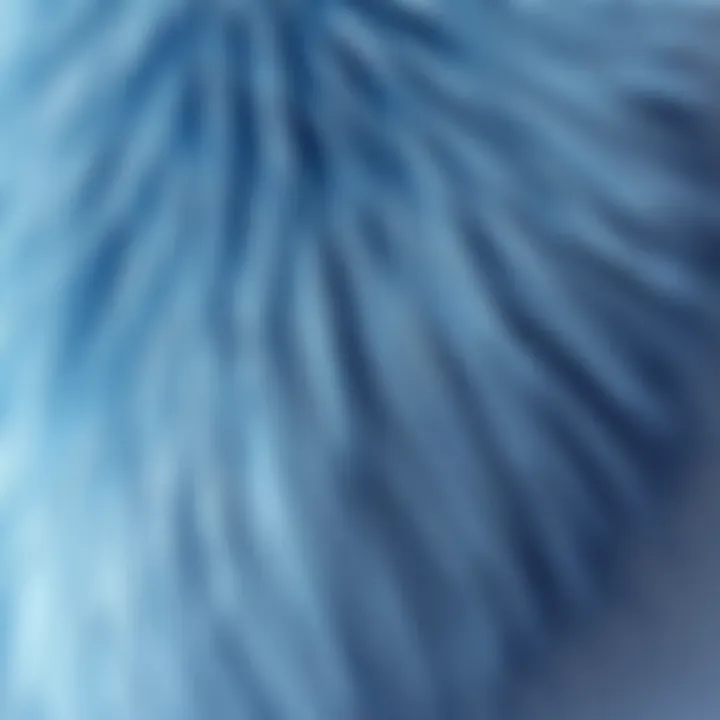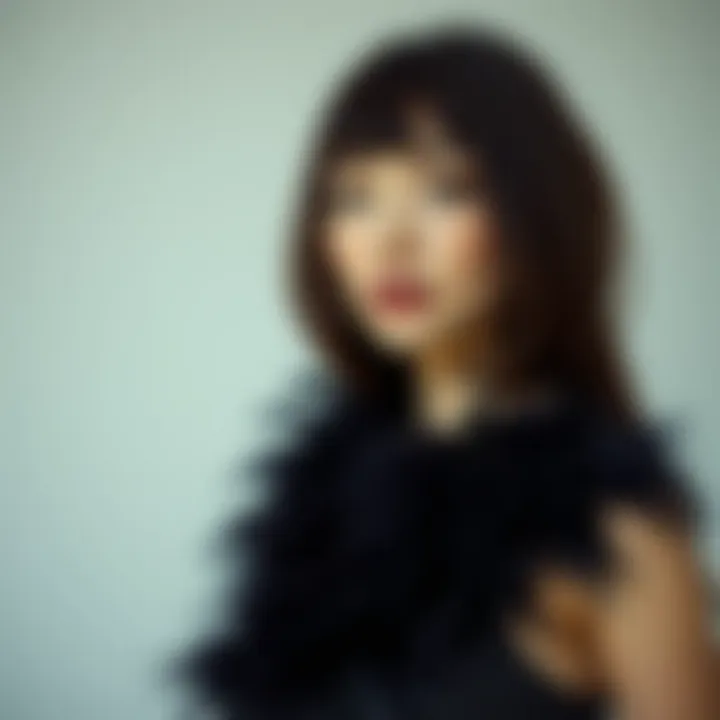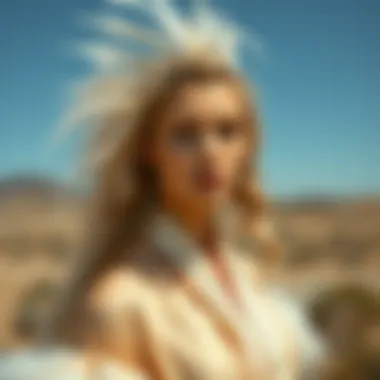Synthetic Hair Feathers in Contemporary Fashion


Intro
In the ever-evolving landscape of fashion, the advent of synthetic hair feathers marks a significant shift. These unique decorations, derived from innovative textiles, have captured the imagination of designers and style enthusiasts alike. As more individuals seek to express their individuality through fashion, synthetic hair feathers emerge not merely as accessories but as statements of identity, creativity, and sustainability. This article will delve deeper into the world of synthetic hair feathers, illuminating the materials, applications, and cultural implications tied to their rise in prominence.
The discussion around synthetic hair feathers isn’t just limited to aesthetics; it branches out into issues of sustainability and maintenance, reflecting broader trends within the fashion industry.
This exploration will guide readers through the intricate web spun by synthetic hair feathers, considering their role in personal expression and the wider cultural currents they affect. From the nuances of their material composition to the wear and care involved in maintaining these feathers, every aspect offers insights into how these textiles fit into the fashion narrative.
As we navigate this journey, we aim to enrich your understanding and appreciation of synthetic hair feathers, exemplifying how contemporary fashion is intertwined with innovation, ethics, and personal style.
Understanding Synthetic Hair Feathers
Synthetic hair feathers have become a noteworthy topic of discussion in the realm of modern fashion. Their rise reflects broader trends in sustainability, creativity, and individual expression. But what exactly are these synthetic feathers, and why have they captured the attention of designers and consumers alike?
Definition and Composition
At its core, synthetic hair feathers are artificial alternatives crafted to mimic the delicate texture and appearance of natural feathers. Made from synthetic fibers, these material can achieve a stunning likeness to real feathers. The composition often varies, ranging from nylon and polyester blends to specialty plastics designed to replicate the organic nuances seen in their natural counterparts. This makes synthetic hair feathers not only versatile but also consistent in quality, unlike some natural feathers which can differ significantly in appearance.
Moreover, the production methods utilized to create synthetic hair feathers can afford designers more control over color and texture, allowing for dazzling new styles that wouldn’t typically be achievable with natural feathers. The blend of creativity and technology behind these materials marks a significant turning point in the industry.
Types of Synthetic Materials
When discussing synthetic hair feathers, it’s essential to understand the various materials used to create them. Each type brings its unique advantages and challenges:
- Nylon: Known for its durability and resistance to tearing, nylon offers a variety of textures and colors, making it a popular choice.
- Polyester: Often used for its affordability and easy care, polyester can imitate the softness of natural feathers while maintaining a vibrant hue.
- Vinyl: This material provides a glossy finish, adding a touch of glamour, especially suitable for evening wear and high-fashion contexts.
- Microfiber: Light and soft, microfiber feathers contribute to an airy, whimsical look, often favored in bohemian styles.
Each type of material presents different possibilities in terms of structural integrity and aesthetics, expanding the creative horizons for fashionistas.
Comparison with Natural Feathers
The debate between synthetic and natural materials often arises in fashion circles. While natural feathers can symbolize luxury and organic beauty, there are several compelling reasons to consider synthetic alternatives:
- Ethical Considerations: Natural feathers often raise concerns about sourcing and animal welfare. Synthetic options eliminate these ethical dilemmas, making them an appealing choice for conscientious consumers.
- Durability: Synthetic hair feathers typically resist wear and tear better than their natural counterparts. They withstand washing and styling, maintaining their appearance longer.
- Color Consistency: Synthetics can be produced in a wide range of colors without the variation found in natural products. This ability to offer uniformity allows designers to execute their visions more accurately.
- Maintenance Ease: Unlike natural feathers, which require special care, synthetic feathers are generally easier to clean and require minimal upkeep.
Fashion Applications of Synthetic Hair Feathers
The world of fashion thrives on innovation, and synthetic hair feathers have found their place within this ever-evolving landscape. By integrating these materials into diverse design elements, designers not only enhance the aesthetics of clothing but also embrace versatility and sustainability, which are progressively more important to modern consumers. The unique characteristics of synthetic hair feathers – including their lightweight nature and ease of maintenance – open up unlimited potential in creative expression.
In Clothing Design
The application of synthetic hair feathers in clothing design has become increasingly prominent. These feathers can transform even the simplest outfits into eye-catching ensembles. For instance, consider a flowing evening gown adorned with delicate strands of synthetic feathers that catch the light with every movement, creating a stunning effect. Designers often utilize these materials to inject texture and depth, allowing for an intricate layering technique that adds intrigue.
Moreover, synthetic hair feathers offer practical advantages. They are often more durable than natural feathers, resisting wear and tear while maintaining their dazzling appearance. This durability makes them favorable for everyday wear, where style must not compromise functionality. Additionally, they can be dyed in a wide array of colors, allowing designers to tailor their creations for specific themes or seasons. With trends like upcycling gaining traction, using synthetic materials aligns with consumers' growing awareness of ethical fashion choices.


As Accessories
Accessories serve as the finishing touch to any outfit, and synthetic hair feathers excel in this realm. They have the power to elevate a look from ordinary to extraordinary. Accessories such as feathered headbands, brooches, and earrings can instantly add flair. For instance, a simple black dress might be paired with a bold feathered collar that captures attention and embodies a spirit of avant-garde fashion.
The lightweight aspect of synthetic feathers makes them an ideal fit for accessories. Their buoyancy allows for larger designs without the burden of extra weight. This becomes particularly significant on occasions where comfort is paramount, such as long events or festivals. Furthermore, price-wise, synthetic hair feathers often come at a lower cost than their natural counterparts, broadening affordability without sacrificing style.
"Accessories are like the punctuation in the sentence of fashion; they bring clarity and meaning to the overall statement."
Usage in Performance and Dance Costumes
In theatrical and performance settings, synthetic hair feathers play a crucial role in costume design. They are the unsung heroes behind captivating visuals that support storytelling. Take, for example, a dance troupe performing a contemporary piece. Costumes embellished with feathers might shimmer and sway in rhythm, providing visual choreography that enhances the entire performance.
These feathers allow performers to express movement and emotion, becoming an extension of their artistry. The textures and colors can indicate character nuances or thematic elements, without the fragility associated with real feathers. In this context, synthetic hair feathers not only fulfill aesthetic needs but also address practical ones, such as durability and ease of cleaning after rigorous performances.
In realms like these, where both visual and emotional impact are key, synthetic hair feathers uphold their undeniable value as irreplaceable design elements. Overall, their incorporation into fashion continues to stretch boundaries and challenge our understanding of what innovation can look like.
Cultural Implications
The emergence of synthetic hair feathers in contemporary fashion carries significant cultural implications that extend well beyond mere aesthetics. This chapter focuses on how these materials resonate with broader cultural narratives and individual identity in diverse communities. They are not merely a trend; they are a statement, a reflection of values, and a medium through which individuals express their personal philosophies.
Historical Context
To understand the current appeal of synthetic hair feathers, it is essential to consider their historical background. Throughout the ages, feathers have held a special place in various cultures, often symbolizing power, freedom, and creativity. In many indigenous tribes, feathers from birds became important ceremonial items, used in rituals to signify strength and connection to the spiritual realm. These intimate associations with nature and spirituality were gradually transformed as societies modernized. With the advent of synthetic alternatives, the accessibility of feather art rose, allowing broader participation in this age-old tradition.
The technological revolution paved the way for innovative uses of synthetic materials, which in turn democratized fashion. No longer are elaborate feathered garments reserved solely for those with significant means. This shift marked an important moment that blurred barriers and opened the doors to self-expression for a wider audience, making fashion more inclusive.
Modern Interpretations
In today’s context, synthetic hair feathers are reinterpreted across various styles, merging traditional aesthetics with contemporary design elements. They can range from extravagant festival wear to chic, everyday fashion pieces. Designers like Iris van Herpen have been known to incorporate synthetic feathers in avant-garde creations that push the envelope of fashion.
Furthermore, social media platforms fuel the evolution of these interpretations by facilitating rapid sharing and fostering community around unique styles. Influencers sometimes juxtapose synthetic feathers against urban streetwear, creating a clash that revolutionizes how we perceive identity and personal style. The versatility of synthetic hair feathers allows people to experiment freely, reinventing classic looks while adding a personal touch.
Symbolism in Fashion
Synthetic hair feathers have evolved from a mere decorative element to a prominent symbol in fashion. They often represent an intersection of various identities and values, such as sustainability and individuality. In a world increasingly conscious of environmental challenges, many choose synthetic options in place of natural feathers, signaling a commitment to ethical fashion practices. This alignment with sustainability becomes a crucial part of personal branding in the fashion realm.
Moreover, synthetic feathers embrace self-expression. They allow wearers to communicate their spirit and creativity. Often, the choice of feather style can signify rebellion against conventional norms, embracing the idea that fashion is a playground for freedom and personal narrative.
"In fashion, every choice is a chance to tell a story. Synthetic feathers, particularly, are a canvas where personal tales can unfold, weaving together tradition and modernity."
As fashion continues to evolve, synthetic hair feathers remain a compelling tool for storytelling, enabling wearers to articulate their unique identities while reflecting broader cultural movements.
Sustainability Considerations
The conversation around sustainability in fashion has gained traction, as environmentally conscious practices influence designers, manufacturers, and consumers alike. In the context of synthetic hair feathers, understanding their sustainability is paramount. The production of these materials has implications that echo throughout the lifecycle of the product, including its environmental impact, durability, and eventual fate after use. By diving into these elements, we can appreciate the dual nature of synthetic hair feathers as both innovative textiles and their responsibilities toward the planet.


Environmental Impact of Production
Synthetic hair feathers are often made from a range of plastic composites and advanced polymers. This opens a can of worms when talking about the environmental toll of their production. The manufacturing process typically involves chemical processes that may not be benign. Many synthetic materials are derived from petroleum, a finite resource that contributes to pollution and greenhouse gas emissions during extraction and refining. Moreover, factories producing these materials can significantly contribute to localized environmental degradation if they cut corners or fail to adhere to stringent environmental regulations.
However, there are efforts underway to shift toward more environmentally friendly practices. Some manufacturers are adopting biodegradable plastics and reducing waste through innovative methods. As consumers become more informed, they are steering brands toward transparency about sustainable sourcing and production methods.
Longevity and Lifecycle
The longevity of synthetic hair feathers can be seen as a double-edged sword. On the one hand, their durability offers a significant advantage, as these feathers can withstand wear, tear, and the rigors of styling demands, making them practical for long-term use. Unlike natural feathers, which might deteriorate rapidly over time, synthetic varieties can maintain their aesthetic appeal considerably longer.
On the other hand, this durability often translates to a longer lifecycle in terms of disposal. When synthetic feathers reach the end of their functional life, they often end up in landfills, contributing to the growing problem of plastic waste. Decomposing synthetic fibers can linger in the environment for decades, if not longer. Therefore, while their longevity is helpful in reducing immediate waste by offering a longer wear time, the overall environmental impact of their production and disposal still requires scrutiny.
Recyclability and Disposal
When discussing the sustainability of synthetic hair feathers, recyclability becomes a crucial factor. Unfortunately, many types of synthetic materials used in hair feathers are not readily recyclable. The complex blend of materials and additives poses challenges for traditional recycling methods. As a result, most synthetic feathers end up in landfills, exacerbating the already pressing issue of plastic pollution.
However, some initiatives are emerging to tackle this problem. Companies exploring closed-loop processes aim to reclaim synthetic textures and reform them into new materials, effectively offering a second life to these products. There’s also a growing trend among fashion designers to encourage consumers to return used materials for recycling. This could facilitate a circular economy, which is essential in minimizing waste and conserving resources.
Conclusion: The sustainability of synthetic hair feathers is intertwined with their production, longevity, and recyclability. By remaining vigilant and advocating for better practices, the fashion industry can enhance its relationship with sustainable development and environmental stewardship. Highlighting awareness in this area helps create a more responsible and informed consumer base.
For further insights into sustainable practices in fashion, you might find these resources informative: Wikipedia on Sustainable Fashion, Britannica on Recycling, and discussions on Reddit about sustainable practices.
Maintenance and Care
When it comes to synthetic hair feathers, understanding the importance of maintenance and care is vital. These innovative textiles have found their way into various fashion applications, but to ensure their longevity and continued vibrance, proper care is essential. From cleaning to repairing, a little attention can go a long way in keeping your synthetic feathers looking fresh and fabulous. This section delves into the crucial elements of maintenance and care for synthetic hair feathers, highlighting how these practices benefit the longevity of your fashion pieces.
Cleaning Methods
Keeping synthetic hair feathers clean is pivotal to retaining their appearance. Unlike natural feathers, synthetic materials are often more resilient yet can still accumulate dirt and oils from hair and skin. Here are some effective cleaning methods:
- Gentle Washing: Use lukewarm water and a mild shampoo or detergent. Soak the feathers briefly, then use your fingers to gently remove dirt. Rinse thoroughly without agitating too much.
- Spot Cleaning: For small stains, employ a soft cloth and a mix of water with vinegar or mild detergent. Dab the stained area lightly until the mark disappears.
- Avoiding Heat: High temperatures can warp synthetic materials. Opt for air-drying instead of using heat sources like hair dryers or direct sunlight.
Remember: Frequent cleans might wear down the feathers, so it's wise to clean only when necessary.
Storage Recommendations
Storing synthetic hair feathers correctly safeguards their structure and aesthetic appeal. Improper storage can lead to tangling, shaping issues, or even damage. Here are practical storage tips:
- Use a Storage Box: Keep feathers in a dedicated box, ideally one lined with a soft fabric to prevent friction and static.
- Hang When Possible: If the feathers are part of a larger piece, hanging them on a padded hanger can maintain their shape.
- Avoid Crushing: Ensure the storage method doesn’t compress the feathers, as this can lead to permanent creasing or damage.
Repairing and Reviving
Over time, synthetic hair feathers may need some tender loving care to bounce back. Repairing and reviving them not only extends their use but can also be a creative process:
- Re-gluing: For feathers with loose parts, a quality fabric glue works wonders. Apply a small amount to the affected area and let it set undisturbed.
- Trimming: If the ends become frayed or shabby, carefully trim them to maintain a neat appearance. Be cautious not to cut too much.
- Restyling: Some synthetic feathers can be restyled with gentle heat. Use a heat-resistant tool on a low setting to reshape, but be attentive to avoid melting the material.


In summary, maintenance and care for synthetic hair feathers are not just routine tasks but an integral part of owning these fashion-forward materials. By incorporating these cleaning methods, smart storage strategies, and repair techniques, one can ensure that feathers remain as eye-catching as the day they were purchased. This thoughtful approach reflects an understanding of the blend between artistic expression and practical fashion sustainability.
Market Trends
Understanding the market trends surrounding synthetic hair feathers is crucial for anyone involved in the fashion industry. These trends not only inform designers and buyers but also reflect broader shifts in consumer preferences, sustainability goals, and cultural narratives. The rising popularity of synthetic hair feathers reflects a growing desire for innovation while recognizing the need for responsible sourcing and production.
Current Popularity Among Designers
Today, numerous designers have embraced the use of synthetic hair feathers in their collections. Unique textures, vivid colors, and the versatility these materials offer are just a few reasons behind this trend. High-end fashion houses and emerging designers alike are weaving synthetic feathers into their designs, elevating garments with eye-catching flair. Notably, brands like Alexander McQueen and Balenciaga have successfully integrated these elements, pushing the boundaries of traditional fashion. The chic allure of synthetic hair feathers allows for creative expression, enabling designers to experiment without the ethical concerns associated with natural feathers.
Furthermore, the rise of eco-conscious consumerism has played a substantial role. Designers understand that today's shoppers are increasingly selective about their choices, often opting for styles that marry aesthetics with ethics. By utilizing synthetic hair feathers, creators can deliver products that resonate with this new demographic. The overall sentiment is clear: style does not have to come at the cost of the environment.
Influence of Social Media
Social media has transformed how trends emerge and proliferate, and synthetic hair feathers are no exception. Platforms like Instagram and TikTok have become vital avenues for showcasing bold fashion choices, where influencers and ordinary users alike are flaunting their unique styles. A simple scroll reveals countless posts featuring synthetic hair feathers, inspiring viewers to embrace these elements in their wardrobes.
The immediacy of social media also fosters quick adoption of new trends. When a popular influencer dons an outfit accentuated with synthetic feathers, followers may rush to replicate that style, creating a ripple effect that can lead to widespread acceptance in mainstream fashion. Moreover, hashtags such as #SustainableFashion and #FeatheredLooks further extend the reach and impact of these materials.
Impact of Celebrity Fashion Choices
Celebrities undeniably hold significant sway over fashion choices. When high-profile figures opt for synthetic hair feathers, they set a precedent that many are eager to follow. In recent awards shows and red carpet events, stars like Beyoncé and Lady Gaga have strutted in eye-popping ensembles that include synthetic feathers, leaving fans and fashion critics alike buzzing with excitement about the trend.
These public appearances introduce synthetic hair feathers to the masses, transforming them from niche elements to fashion staples. Additionally, celebrities often leverage their platforms to advocate for sustainable practices in fashion, drawing attention to environmentally-friendly alternatives. This endorsement not only enriches the narrative around synthetic hair feathers but also reassures consumers that these styles are not merely a passing fad, but part of a larger commitment to mindful consumption and innovation.
"Fashion is what you’re offered four times a year by designers. And style is what you choose." - Lauren Hutton
Future Prospects of Synthetic Hair Feathers
The future of synthetic hair feathers is both intriguing and multifaceted within the fashion industry. As innovations in technology progress and environmental consciousness rises, synthetic hair feathers are poised to take on a more prominent role. In this section, we will delve into technological advancements in materials, anticipated fashion trends, and the industry's movement toward more sustainable practices.
Technological Innovations in Materials
Synthetic hair feathers are benefitting from cutting-edge advancements in textiles. Researchers and manufacturers are continually refining the types of polymers and blends used in creating these unique materials. For instance, new techniques are emerging that allow for the simulation of natural feather characteristics. This could involve using bio-based materials or blends that mimic not just the appearance but also the texture of real feathers, enhancing overall visual and tactile appeal in fashion applications.
A notable example is the development of moisture-resistant synthetic feathers that remain lightweight despite various environmental conditions. Moreover, implementing nanotechnology could improve the durability of these materials, making them more resilient against daily wear and tear. Such innovations ensure that designers have a wider palette to work from, cultivating the creativity needed for bold, eye-catching designs.
Predicted Fashion Trends
As we look to the horizon, a few key trends appear likely to shape the future of synthetic hair feathers in the fashion world. First, there's a growing inclination towards bespoke and personalized fashion. Designers might leverage synthetic hair feathers to create custom pieces that cater to individual tastes and preferences. This tailor-made approach emphasize uniqueness, allowing wearers to express their personality through fashion effectively.
Another critical trend on the rise is the fusion of technology and fashion. Incorporating digital fabrics or responsive textiles, which change color or shape through electronic means, could lead to stunning designs featuring synthetic hair feathers. Imagine garments that adjust their appearance based on ambient light or user interaction. Such materials could transform the idea of fashion from static to dynamic, making every piece truly one-of-a-kind.
Industry Movements Toward Sustainability
Sustainability is no longer a fringe discussion in the fashion industry; it’s become a core value driving changes in how products are developed. The production of synthetic hair feathers is increasingly being scrutinized for its environmental implications. To that end, many companies are re-evaluating their supply chains to prioritize eco-friendly manufacturing processes. This could include using recycled materials or approaches that minimize carbon emissions.
Moreover, sustainable practices such as "upcycling"—transforming pre-used textiles into new designs—can enhance the lifecycle of synthetic hair feathers. Brands are also likely to implement take-back programs, allowing consumers to return products at the end of their life cycle, contributing to a circular economy. These progressive movements could very well redefine the industry's landscape, aligning consumer demand with responsible production standards.
"The blend of innovation and sustainability is reshaping how we perceive and create fashion, offering endless possibilities for creative expression while caring for our planet."
As synthetic hair feathers continue to evolve, their role in fashion will likewise reflect broader societal and environmental values, signaling a shift toward a more thoughtful and innovative approach in the industry.







